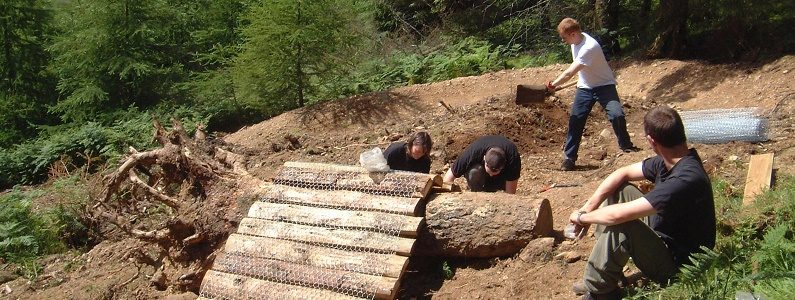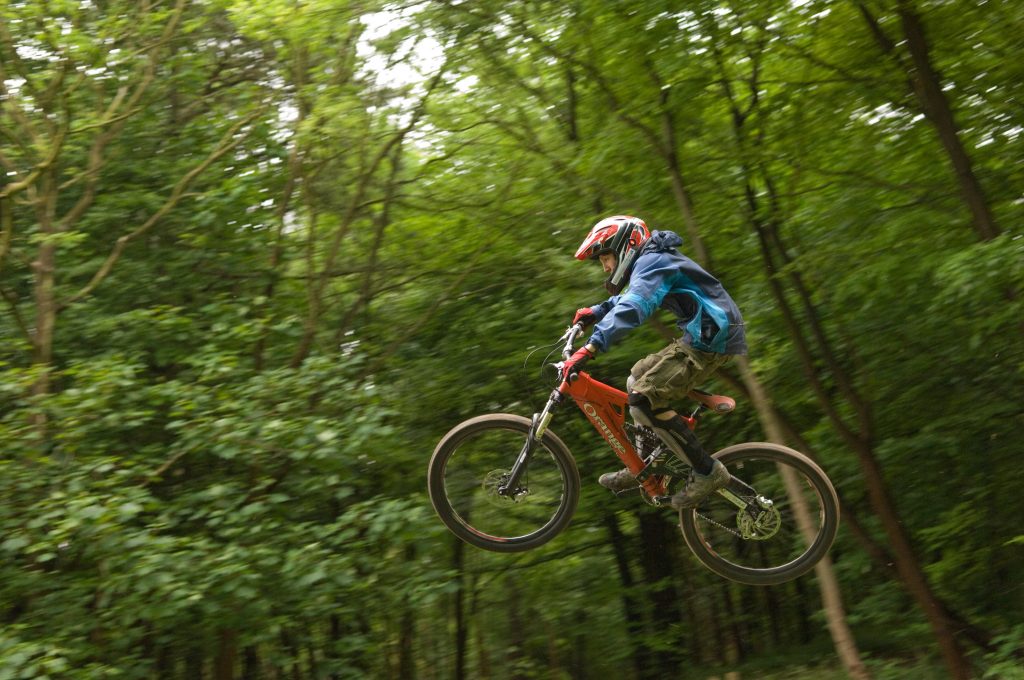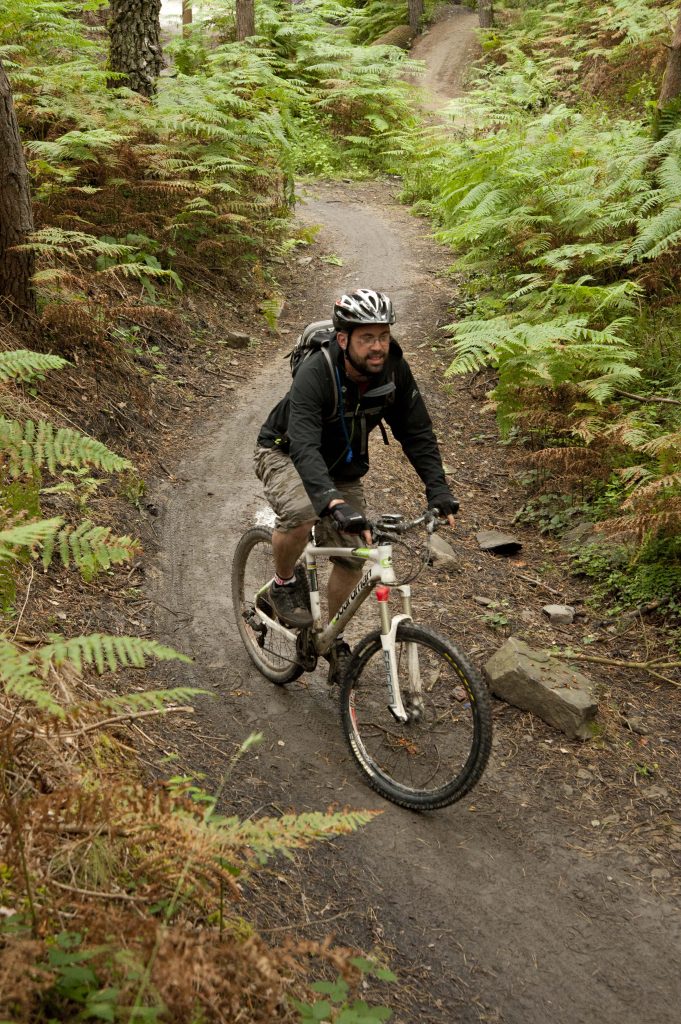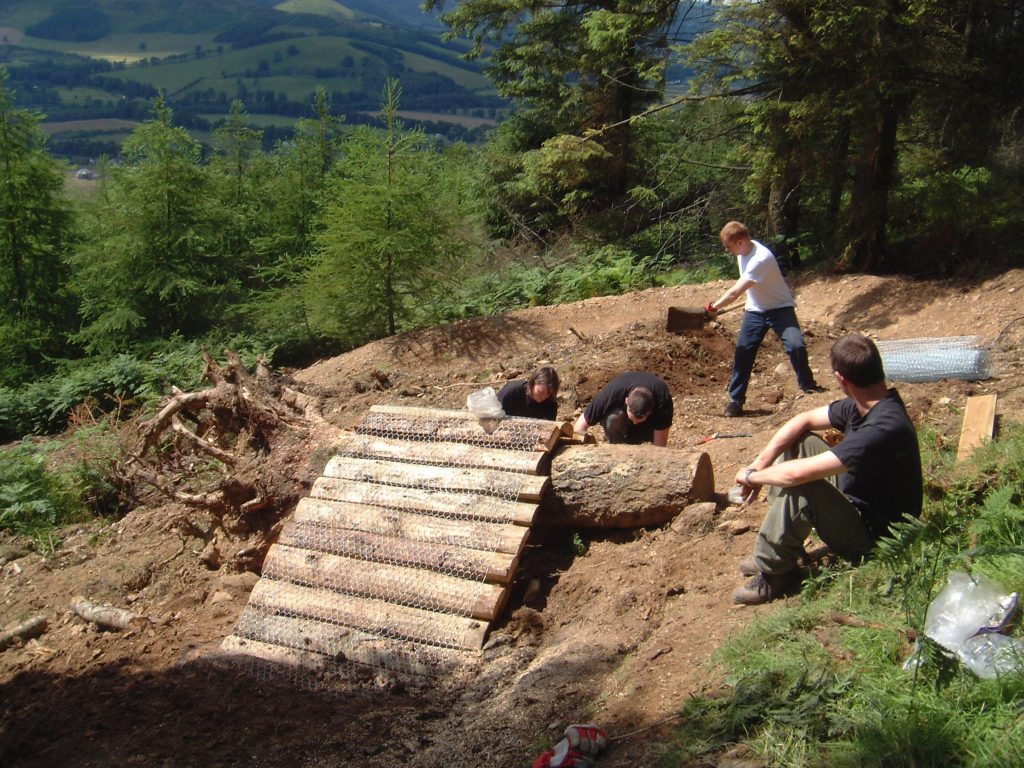By Bridgette Hall, Recreation Manager, Forestry Commission England
(in Volume 26)
Forestry Commission England (FCE) manage a network of off-road cycle trails that at the last count extends for 1242 km, that is roughly the combined length of the M1, M4, M5, M6 motorways, or a distance fractionally shorter than the official route from Land’s End to John O’Groats. If you were to cycle every kilometre you would encounter flat wide trails that you could cycle along on a unicycle, through to extreme down-hill mountain bike route requiring body armour and a full suspension bike.
With such an extensive network to manage, and mountain bikers’ love of building new unauthorised trails, jumps and berms by wild trail enthusiasts, it is certainly true that the degree of risk that has developed over the years for the Forestry Commission is considerable.
Processes for mitigating this risk have also developed over the years and now form the bed-rock of policies providing a safe and enjoyable cycle experience whether you are a rider or you use the same woodland space for walking, horse riding, or running.
Accidents occurring on FCE cycle trails and subsequently reported to local teams total just over 100 annually, and approximately 80% are accidents to adult males. This mirrors the statistics cited by ROSPA for on-road accidents. The main difference being that cycling on our British roads results in approximately 109 fatalities per annum. [1]
Also mirroring the trends in on-road accident reporting[2], the majority of injuries sustained are to arms, shoulders, knees and legs. Head injuries number approximately 11% of reported accidents and tend to reflect those where riders are not wearing any or the correct head protection.
What happens when it all goes wrong?
As recognised in the extensive study by Bennett & Crowe (2008)[3] ‘the perceptions of landowner liability is also influenced by more general social and cultural trends’. Sadly, with a steady stream of ‘no win – no fee’ personal injury company adverts assailing our senses, the FC is not immune to public liability claims being made, usually under the Occupiers Liability Acts of 1957 or 1984. A policy decision nearly twenty years ago by the Forestry Commission resulted in a robust line in defence being established.
The basis for this defence is grounded in case law created in the early 2000’s and robust management practices that stem from the findings. The case upon which many defence cases have since been predicated begins with Tomlinson versus Congleton Borough Council in 2003. The decision of the House of Lords relates to an injury sustained as a result of a voluntary dive by Mr Tomlinson into a lake within a public park managed by Congleton Borough Council. Mr Tomlinson sustained injuries which left him paralysed. The Council argued that there was sufficient signage in place to warn Mr Tomlinson not to swim, and in proceeding to do so he went outside the parameters of the permission to be on the land, so that he then became a trespasser. The claim was then determined in accordance with Section 1 of the Occupiers Liability Act 1984 (duties owed to trespassers). However, in exploring the nuances of the case the Lords spoke in depth about the “common duty of care” owed by occupiers to all land users.
In his Judgment Lord Hoffman stated that the common duty of care was “such care as in all the circumstances of the case was reasonable” and in deciding this question it depends on assessing and balancing four factors, being the likelihood of injury, the seriousness of the injury which may occur, the social value of the activity which gives rise to the risk, and the cost of preventative measures. In dismissing the claim Lord Hoffman stated that “Mr Tomlinson was a person of full capacity who voluntarily and without any pressure or inducement engaged in an activity which has inherent risk”[4]. He went on to recognise that “any premises can be said to be dangerous to someone who chooses to use them for some dangerous activity”. There was not a duty to protect against “obvious risks” unless there was no genuine free choice or for vulnerable groups. These four balancing factors are just as important to management practices today.
This judgement has been quoted many times since 2004, and in June this year was used in evidence by FCE as a defendant in Liverpool County Court (Hewitt vs Forestry Commission). Interestingly, this case centred around the use and management of a user built cycle skills area called ‘No Brains’ at Delamere forest in Cheshire. In this case the claimant was a mountain biker with a specialist down-hill full-suspension bike, full-face helmet and considerable experience of riding, including at Delamere. Mr Hewitt claimed that he did not see the signage at various entrance points around the No Brains area, he did not know that a gap jump was present on the trail, and the injuries he sustained on his visit were a result of a failure of the duty of care by FCE.
The claim was not upheld on two counts, firstly the Claimant was found on the balance of probabilities that he went there with the specific intention of riding the jump and as such had voluntarily accepted the risk. Secondly, that in any event FCE management practices; signage, grading, risk assessment, inspections, record keeping and pragmatic but active management of a wild trail area were all sufficient to discharge a duty of care. The Judge found that FCE did not need to erect signs on every individual feature within the No Brains area, or to use a digger to remove a feature that was part of the nature of the sport. He also recognised the culture surrounding the down-hill mountain biking community and the sporting and social value gained by mountain bikers who build and ride their own facilities. This was clearly a win for the sport, active land managers and the down-hill biking community.
However, as cyclists and mountain bikers find new ways to enjoy their sport, so the boundaries of the Hoffman judgement continue to be pushed. In 2013 FCE also found itself defending a public liability claim from a cyclist who sustained an injury whilst night riding in the New Forest. As with the Hewitt claim, the cyclist was not using a purpose-built facility but was riding with friends along a disused railway embankment at night, when he cycled into a tall metal post which was a relic of the railway. The metal post was highly visible by day and therefore no action had been taken to remove it or to mark it with any reflective device. In this case, the Judge made a factual decision to dismiss the claim on the basis that the cause of the accident was the Claimant riding too fast and not paying sufficient attention to possible hazards.
Risks and benefits
As cycling continues to evolve, as new more extreme events are created, as new mountain bikes are developed with the latest being battery powered, and as generation after generation of people discover the thrills and social benefits of mountain biking, the accidents will keep occurring. FCE is now taking a proactive approach to formally recognising the risks versus the benefits of cycling as an activity. A fresh look at the management of unofficial or ‘wild trails’ and desire lines has already taken place. We are now looking at national policies to ensure that they recognise the value of working with local riders and trail builders to ensure a balance between responsible land management and the enjoyment of the sport.
Building on the industry principles enshrined in the work of the Visitor Safety in the Countryside Group (VSCG), FCE are developing a decision making framework for local forest managers to gauge reasonableness in their risk management and allow consideration of the benefits to riders of a particular trail or challenging feature. Given the appetite of the mountain bike community for risk taking, one of the factors under consideration is the likelihood that riders will seek out risks elsewhere, in places that are not controlled or designed for them.
So is the provision of cycle facilities, whether they are challenging or not, a risky business? Is tolerating the construction of unofficial trails and features of high risk to the land manager? Of course it is. However, it does depend on whether you are prepared to view the risk both positively and negatively. Giving millions of people the opportunity to participate in safe, managed, challenging cycling experience, accepting that a few will sustain injuries, sometimes life-changing injuries, is the reality of that decision making process.
You need to be prepared to look through dozens of accident reports to assess whether the benefits outweigh the risks, and that the management techniques in place are robust in identifying and remedying the situation if the risks begin to outweigh the benefits too greatly.
If we look back at the Tomlinson judgement in 2004, Lord Hobhouse stated ‘ …it is not and should never be the policy of the law to require the protection of the foolhardy or reckless few to deprive, or interfere with, the enjoyment by the remainder of society of the liberties and amenities to which they are rightly entitled’ (4).
Bridgette Hall
Recreation Manager, Forestry Commission England
References
[1] ROSPA: Cycling Accidents Facts and Figures 2014
[2] How safe is cycling? It’s Hard to say, Gina Kolata, New York Times, 23 October 2013
[3] Landowners’ Liability? L Bennett & L Crowe, Sheffield Hallam University (2008)
[4] Tomlinson v Congleton Borough Council (2004) 1 AC 46, (2003) 3 All ER 1122




